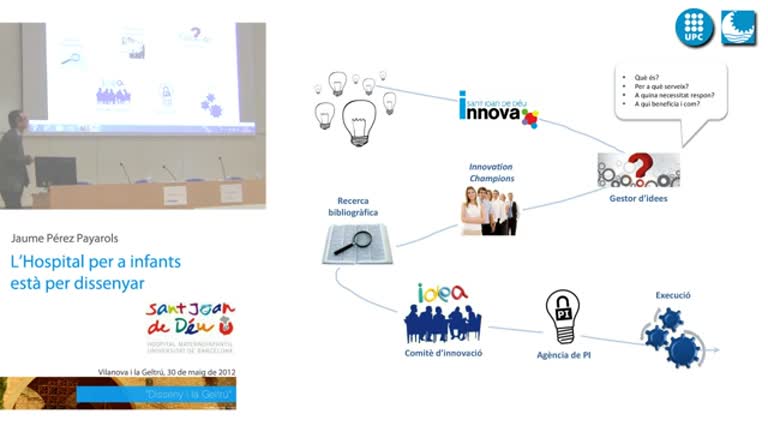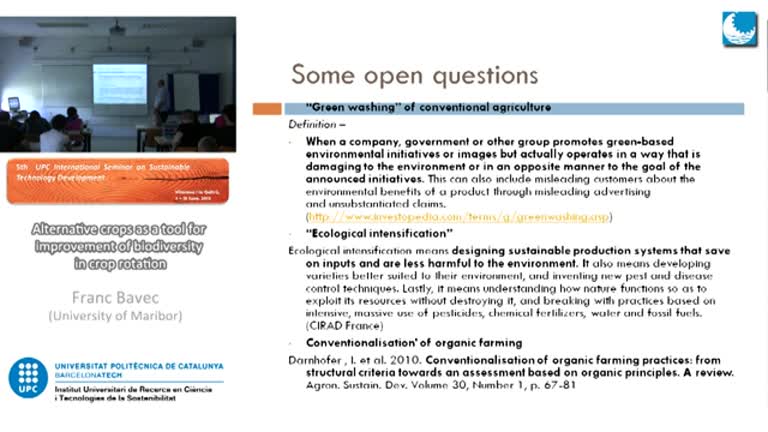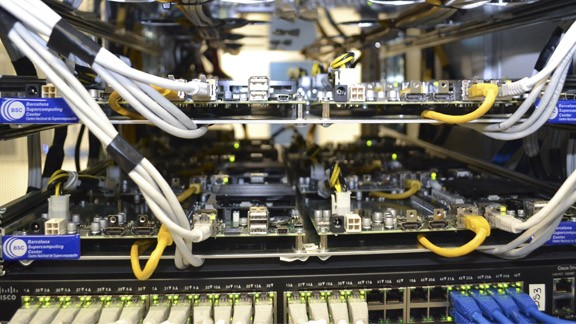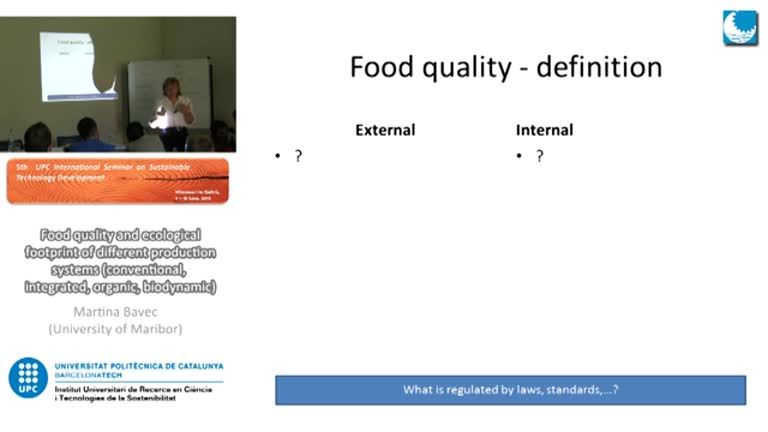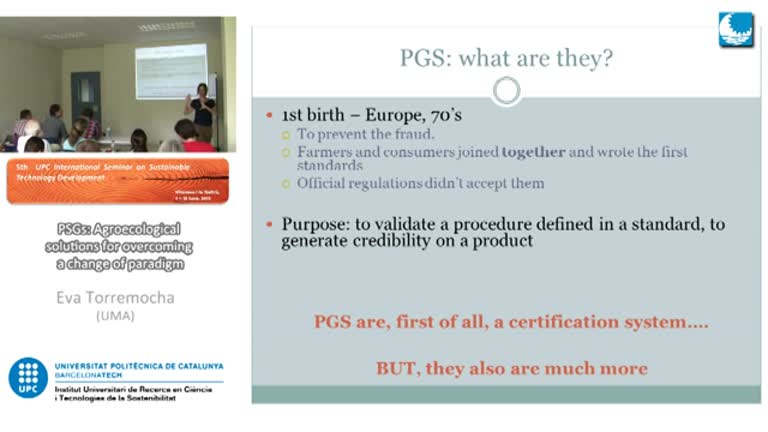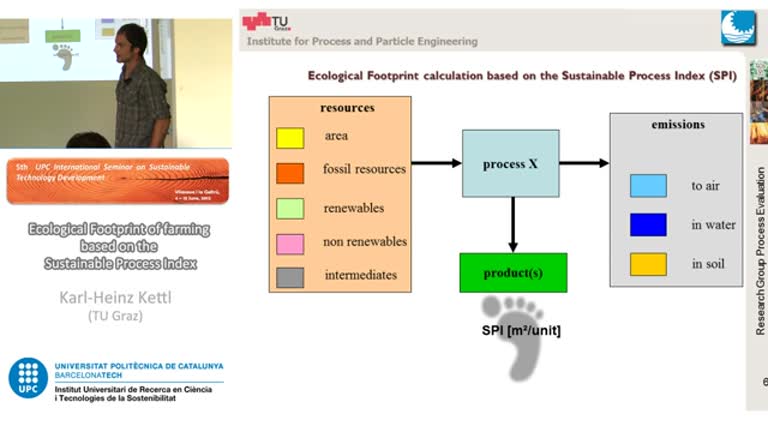Objectes multimèdia amb l’etiqueta: Difusió de la recerca
Resultats de la cerca
El grafè, futur substitut del silici?
Accés obert
2 de des. 2012
La capacitat de conducció del grafè ha fet plantejar la possibilitat que esdevingui un possible material alternatiu al silici en la fabricació dels futurs dispositius informàtics i electrònics. L’investigador Roberto Macovez, del Departament de Física i Enginyeria Nuclear, explica en aquest vídeo les principals propietats d’aquest material i les seves possibles aplicacions. En aquest sentit, la comunitat científica considera que es tracta d’un material que pot revolucionar la tecnologia electrònica actual, especialment quan se n'aconsegueixi optimitzar la producció industrial.
[SC 2012] La Ciència en primera persona : 'Medicanes' possibles huracans a la Mediterrània
Accés obert
21 de nov. 2012
Conferència duta a terme dins el marc de la Setmana de la Ciència 2012 a l'EPSEVG. A càrrec de Dani Ramírez, del programa Espai Terra (TV3).
[SC 2012] Canvi climàtic i pobresa
Accés obert
19 de nov. 2012
Conferència duta a terme dins el marc de la Setmana de la Ciència 2012 a l'EPSEVG. A càrrec d'Enric Garriga, Responsable de l’equip agenda-21 a Vilanova i la Geltrú.
El Disseny a la indústria del coneixement
Accés obert
15 de nov. 2012
Javier Nieto, president de Santa & Cole, editora d’elements de mobiliari i d’il·luminació, domèstics i urbans, d’elements vegetals i de llibres, presenta la singular diversificació del seu catàleg, que combina els elements bàsics, terra, llum, vida i coneixement, tingui molt a veure amb la capacitat que té l'empresa com a organització, per a viure el disseny com poques empreses ho poden fer.
L'Hospital per a infants està per dissenyar
Accés obert
25 d’oct. 2012
Jaume Pérez Payarols, metge pediatre, especialista en oncologia pediàtrica, expert en gestió hospitalària per l'IESE i responsable d'innovació de l'Hospital de Sant Joan de Déu, ens mostra la feina que manca per fer en els serveis dels centres sanitaris destinats als infants. Actualment la major part dels productes i materials amb els que aquest pacients, nens i nenes, interactuen els han dissenyat adults, pensant en ells mateixos. Les possibilitats de millora, simplement en l’adaptació a l’escala dels nens, són moltes.
Un simple suport per a la bossa de sèrum pot convertir-se, per un infant, en un patinet que li permeti lliscar pels passadissos d'un hospital, per exemple.
Un simple suport per a la bossa de sèrum pot convertir-se, per un infant, en un patinet que li permeti lliscar pels passadissos d'un hospital, per exemple.
El Bon disseny s'ha de poder fer vell
Accés obert
20 de set. 2012
Les jornades Disseny i la Geltrú van néixer per refermar l’aposta que fa el Campus de la UPC de Vilanova i la Geltrú pel Disseny Industrial. Es tracta d’unes activitats entorn al món del disseny que volen, per una banda, complimentar la formació en el Grau en Enginyeria de Disseny Industrial i Desenvolupament del Producte que s’imparteix al Campus, i a la vegada, acostar el professional del sector a la Universitat.
'El bon disseny s’ha de poder fer vell’ és la tercera conferència del cicle ‘Disseny i la Geltrú’.
www.epsevg.upc.edu/disseny-i-la-geltru.
Amb el títol ‘El bon disseny s’ha de poder fer vell’, l'enginyer i dissenyador Josep Congost parla de com els fets quotidians ens donen l’oportunitat per a fer bonys dissenys, i que aquests dissenys, no els objectes, perduri en el temps. Josep Congost manté que els dissenys s’han de poder fer vells. El disseny va més allà del producte en sí. Afirma que els bons dissenys han de poder envellir i guanyar el seu valor a mesura que els usuaris els fan servir i els gaudeixen. Els productes sanitaris en són un bon exemple, ja que satisfan necessitats reals de les persones a la seva vida diària i això és una gran oportunitat per un/a dissenyador/a.
'El bon disseny s’ha de poder fer vell’ és la tercera conferència del cicle ‘Disseny i la Geltrú’.
www.epsevg.upc.edu/disseny-i-la-geltru.
Amb el títol ‘El bon disseny s’ha de poder fer vell’, l'enginyer i dissenyador Josep Congost parla de com els fets quotidians ens donen l’oportunitat per a fer bonys dissenys, i que aquests dissenys, no els objectes, perduri en el temps. Josep Congost manté que els dissenys s’han de poder fer vells. El disseny va més allà del producte en sí. Afirma que els bons dissenys han de poder envellir i guanyar el seu valor a mesura que els usuaris els fan servir i els gaudeixen. Els productes sanitaris en són un bon exemple, ja que satisfan necessitats reals de les persones a la seva vida diària i això és una gran oportunitat per un/a dissenyador/a.
Alternative crops as a tool for improvement of biodiversity in crop rotation
Accés obert
13 de juny 2012
Resolució de problemes enormes a baix cost: supercomputació amb tecnologia smartphone
Accés obert
12 de juny 2012
Gairebé el 40% dels joves espanyols entre 18 i 24 anys utilitzen telèfons 'intel·ligents’, els anomenats smartphones. Més enllà de les trucades i els wassups, els smartphones o mòbils intel·ligents són dispositius tecnològicament punters, amb prestacions que els converteixen en autèntics ordinadors en miniatura.
Precisament amb la idea d’aprofitar la tecnologia dels smartphones i les tablets, un equip d’investigadors del Barcelona Supercomputing Center – Centro Nacional de Supercomputación (BSC-CNS) està dissenyant un prototip del que serà el primer superordinador del món basat en tecnologia de telèfon mòbil.
Amb la idea d’aprofitar l’eficiència que aporta el consum energètic dels smartphones i les tablets – la major part del temps no estan endollats a la xarxa elèctrica i funcionen sense sobre escalfar-se –, un equip de recerca està dissenyant el prototip d’un nou supercomputador amb major capacitat de càlcul i que no augmenti la despesa energètica. És l’objectiu de Mont-Blanc, projecte coordinat per Àlex Ramírez, investigador del Barcelona Supercomputing Center – Centro Nacional de Supercomputación (BSC-CNS) i professor del Departament d'Arquitectura de Computadors.
Precisament amb la idea d’aprofitar la tecnologia dels smartphones i les tablets, un equip d’investigadors del Barcelona Supercomputing Center – Centro Nacional de Supercomputación (BSC-CNS) està dissenyant un prototip del que serà el primer superordinador del món basat en tecnologia de telèfon mòbil.
Amb la idea d’aprofitar l’eficiència que aporta el consum energètic dels smartphones i les tablets – la major part del temps no estan endollats a la xarxa elèctrica i funcionen sense sobre escalfar-se –, un equip de recerca està dissenyant el prototip d’un nou supercomputador amb major capacitat de càlcul i que no augmenti la despesa energètica. És l’objectiu de Mont-Blanc, projecte coordinat per Àlex Ramírez, investigador del Barcelona Supercomputing Center – Centro Nacional de Supercomputación (BSC-CNS) i professor del Departament d'Arquitectura de Computadors.
PSGs : agroecological solutions for overcoming a change of paradigm
Accés obert
11 de juny 2012
Participatory Systems of Guarantee (PSGs) arise when proposed by civil society, revolving around the production and commercialization of ecological foods. They are constructed as an alternative to the model of certification by a third party, in order to guarantee that productive initiatives which are not covered by the official system are still able to access the certified product sector / market.
Their dynamism is that they are constantly evaluating and reviewing their structures and procedures, as a result of their constant interaction with their environment. Given this characteristic, in reality PSGs are reaching great levels of complexity, not only internally – as part of the same system – but in a global sense, where organizations are using a number of them in line with diverse criteria.
Their social design and focus on the system, as well as the sensitivity that they show for processes of co-evolution, allow us to visualize them as one of the possible tools that will permit the transition from one system to another.
The systems themselves (integrated in political agroecology), and the activities that they encourage, widen the options for agroecological approaches. These can then be applied in territories that are working towards greater sustainability.
Their dynamism is that they are constantly evaluating and reviewing their structures and procedures, as a result of their constant interaction with their environment. Given this characteristic, in reality PSGs are reaching great levels of complexity, not only internally – as part of the same system – but in a global sense, where organizations are using a number of them in line with diverse criteria.
Their social design and focus on the system, as well as the sensitivity that they show for processes of co-evolution, allow us to visualize them as one of the possible tools that will permit the transition from one system to another.
The systems themselves (integrated in political agroecology), and the activities that they encourage, widen the options for agroecological approaches. These can then be applied in territories that are working towards greater sustainability.



![[SC 2012] La Ciència en primera persona : 'Medicanes' possibles huracans a la Mediterrània](/uploads/pic/series/6040aa649e8fe0002b5e5184/video/604274179e8fe0115069e6c0/210305195818.jpg)
![[SC 2012] Canvi climàtic i pobresa](/uploads/pic/series/6040aa649e8fe0002b5e5184/video/604274079e8fe011593d23a4/210305195649.jpg)

